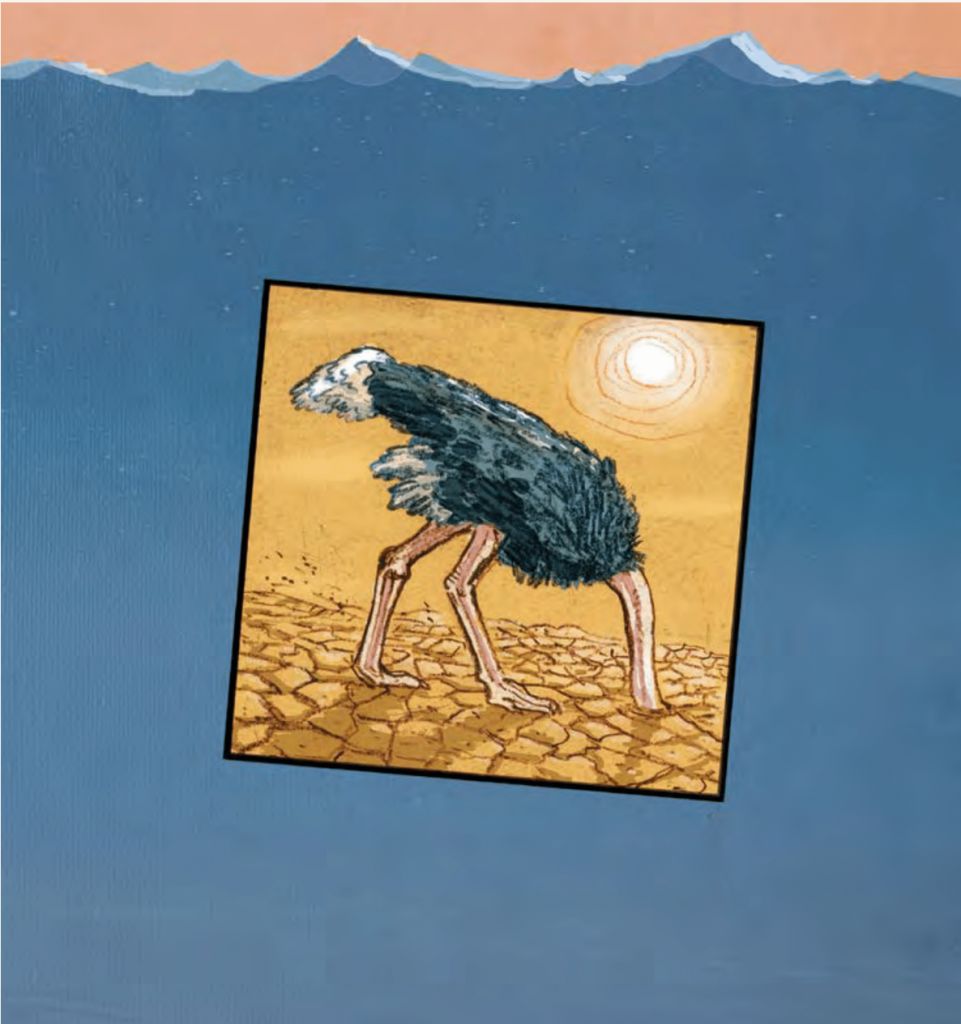It must be exhausting to awaken every morning knowing that the Earth will self-destruct at any time. It must be even more disconcerting to be the self-appointed chronicler of said apocalypse. But that’s what cartoonist and political commentator Peter Kuper, a founder of the 30-year-plus World War III Illustrated comic book, decided to do early in his career.
It is not that Kuper’s art is dour by nature, but it is telling that many of his comics, cartoons, illustrations and graphic novels shed light on the heart of darkness. His latest, Wish We Weren’t Here: Postcards From the Apocalypse (Fantagraphics), has been dubbed “poignant and hilarious, depressing and inspiring” by CBS News host Jake Tapper. Other than a brief introduction by Kuper in which he says the “images warn of impending dangers,” the book is wordless. Comprised of one four-panel self-contained existential notation per page, accompanied by quotes from famous thinkers (Albert Einstein, Bob Dylan, Robert Frost, Rachel Carson) and excerpts from news stories, his themes are the usual litany of climate destruction (in all its horrific forms), excessive greed, depletion of natural resources and all the other nightmare scenarios that greet us daily.
You may ask why we need to be reminded of the dangers we have been warned about day after day, year after year … and Kuper’s first drawing gives a little hint. What’s more, there can never be too many reminders of the imminent black hole humankind is creating for itself.
How do you feel about covering ground that continues to be unresolved?
Part of the challenge of addressing environmental issues is keeping up with that distressing news and seeing how much we know about the problems and how little governments and businesses are doing to curb them. The Trump administration is in fact racing in the direction of increasing and speeding up the damage. One of the reasons I was anxious to get this collection out was to respond to the attitude that is calling climate change a hoax, or worse still, wanting to erase the term completely!
This wordless format forces you to rely on common images. Does that hamper your creativity in any way?
In many ways the wordless format is a perfect approach for me since I’m speechless about what’s happening!
I have long loved wordless storytelling,beginning with seeing MAD artists like Sergio Aragones and Antonio Prohias’ Spy vs Spy. (Ironically, I’ve ended up writing and drawing that feature for nearly 30 years—I’m working on MAD’s next cover and a new story at this very moment.) I later discovered artists like Franz Masereel and Lynd Ward that brought additional artistic inspiration.
To convey ideas with pictures alone functions as an international language. It also causes me to think in more visually abstract terms that I think can make the subject matter more accessible and poetic. The readers are completing the puzzles in their minds as the images unfold, which is more interactive.
Where did these mini-strips first appear? And why?
The comics in Wish We Weren’t Here are drawn from a weekly strip I’ve been doing for the French magazine Charlie Hebdo for the last five years. It sits on the page in a vertical format next to environmental columnists. Since I don’t speak French, this was an ideal format for me and the editors—though I do send them a headline they translate at the top of each strip that gives context to the comics. I’ve included these headlines at the bottom of the Wish comics so readers can explore the subjects further if they choose.
I had experimented with the wordless format beginning with Eye of the Beholder. Steve, you asked me to propose a strip to The New York Times‘ new City section back in 1993. It was the first comic to ever run regularly in the Times. It lasted six months and then I self-syndicated it to alternative papers for nearly 10 years, so I’ve had a lot of practice with this form of storytelling.
I’ve also used the wordless approach on graphic novels including The System (done for DC/Vertigo and more recently published by PM Press) and Sticks and Stones, done for Random House’s Three Rivers Press.
I also co-edited an issue of World War 3 Illustrated of all wordless comics, aiming to break language barriers with the magazine, at least for an issue. Environmental issues are also built into my last book, Insectopolis, and sections of that book are also wordless.
Are you done with this particular theme now?
Though I am feeling dire about where things are headed, I feel like art can connect us, give us some clarity on reality that I hope will prove useful in attacking these problems.
The post The Daily Heller: Peter Kuper’s Postcards From the Black Hole appeared first on PRINT Magazine.

